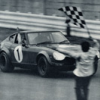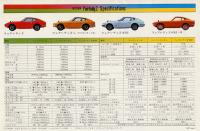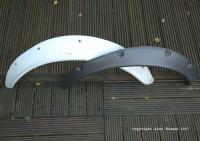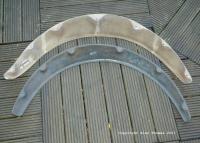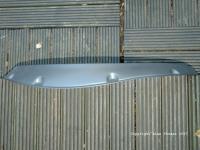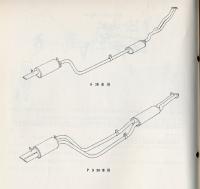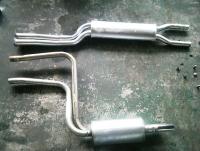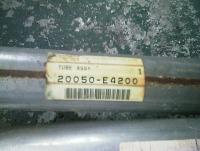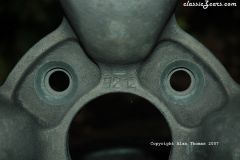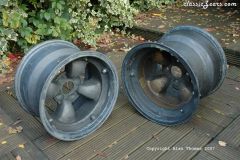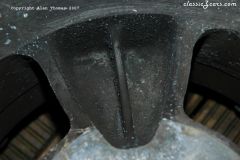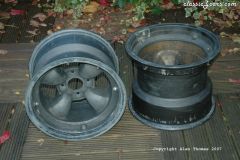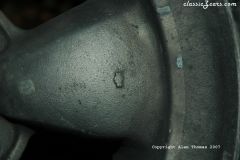Everything posted by HS30-H
-
So yeah, the VIN is fake
Ray appears to have recently signed up as a member ( again going by the screen-name 'Prince' ) over at the Japanese Nostalgic Car forums: http://www.japanesenostalgiccar.com/forum/viewtopic.php?t=921 Maybe that would be a good place to ask him some questions in public? In my opinion, the man ought to be blackballed by any Nissan / Prince / Datsun community that he is a part of. I can't see how he can claim innocence of this prefix changing. Mat, My impression ( based partly on private e-mails that he sent to me about the car's identity ) was that he didn't originally realise that the KPGC10 had it's own body number sequence, and he was under the impression that all GC110s shared a common body sequence. Hence he didn't alter the body serial number on his car, leaving it as a too-high anomaly. This is one of the things that set the alarm bells ringing. Overall, I think there's a big possibility that he originally started down this path just to satisfy his own needs - and wasn't necessarily thinking about defrauding anyone. I reckon he might have gone too far down the road of no return, and having obtained paperwork to match up with the faked prefix he could not turn back. Ultimately, he just fooled himself. Alan T.
-
Datsun-240z Vs Fairlady-z432
Kats, I'm surprised to see you write that the Z432-R model was not listed in the domestic brochures, as I have two early brochures in my collection where it very clearly was listed. The clearest of these - the 'Your Dream Comes True' campaign poster-size fold-out with the red bonnet front cover - you showed in your latest post....... Here's a close-up of the back cover, with the Z432-R on the top right:
-
So yeah, the VIN is fake
Brian, As has been mentioned, at least you now have the satisfaction of knowing the truth about the car's identity - which clears up a lot of speculation and past mysteries. Hats off to you for getting to the bottom of it and posting your findings here. You obviously have the honesty and integrity that the previous owner was lacking......... Just in case anyone wants to look a little deeper into the story, the car was originally discussed here: Introduction by owner: http://www.classiczcars.com/forums/showthread.php?t=12221 Part 2: http://www.classiczcars.com/forums/showthread.php?t=12259 ...and then we had a deeper discussion about it here, when it was offered for sale and finally purchased by Brian: http://www.classiczcars.com/forums/showthread.php?t=24937 Best wishes to you and the car for the future, Brian. I know you are going to make it into a beauty, and won't need to be telling any fibs about it's true identity in the way that the previous owner did. Alan T
-
Unusual Kenmeri QLD
Interesting development with regard to the true identity of the car that this thread originally discussed: http://classiczcars.com/forums/showthread.php?threadid=29117
-
How to get info from my VIN# edit
GS31-010985 is a 'Fairlady Z 2/2' model, built in mid-1977. I'd *estimate* a build date of around June or July 1977 judging by the serial number, but if you have a poke around on the car you will easily be able to get closer to the manufacturing month by cross-referencing quality control stamps on the individual components of the car. We have covered the subject many times on this forum in the past, so use the SEARCH button to dredge up some useful info. There are three spec possibilities if the car is manual trans, and two spec possibilities if it is automatic trans: Manual = GS31-S 'Fairlady Z-L', GS31 'Fairlady Z' or GS31-J 'Fairlady Z-T'. Auto = GS31-A 'Fairlady Z-L' or GS31-AJ 'Fairlady Z-T'. 'Z-T' models had the 'higher' ( ie more expensive ) spec. 'Z-L' was considered 'normal' ( or deluxe ) spec. 'Z' was the bargain basement no frills spec. ( ironically rarest these days ). If it has a 4-speed manual trans it is most likely a GS31-S, but I would have thought that if somebody had taken the trouble to export it outside Japan then it will be more likely that it is either a 'Z-L' or 'Z-T' with a 5-speed manual trans or auto. Diff ratio will depend on model, but all the GS31s left the factory with the NAPS ( Nissan Anti Pollution System ) version of the L20AE, and the exact spec of the engine again will depend on model type, and whether manual or auto trans. Original engine numbers for the S31 models ( both two seater and 2/2 ) started at L20-265834 according to period Nissan documentation, so you can expect your engine number to be higher than that by many thousands. Your original engine bay data plate probably would not state the engine number. Specs and details on these late Japanese market S31 models are very complicated, and the customer had many options available to choose from when ordering his new car - so the final product can vary somewhat from original brochure specs. Makes your life as the new owner a little more interesting........ Alan T.
-
Triple Carb vs. Holley 4BBL Carb
Wow Carl, 20 months ago - on this very forum - you were dismissing Hiroshi Iida and that Nostalgic Hero article in favour of your own '1966 as Year Zero' theories. What happened? Did you have another Road To Damascus* moment? ( * not to be confused with any old movies starring Bob Hope and Bing Crosby ). Sorry, are you talking about TonyD or CarlB here? Tony, Watch out for the stragglers from the HUAC that are still at large - they'll be knocking on your door soon if you are not careful. They'd have been knocking on my door too by now, 'cept none of them seem to own a valid passport............. Alan T.
-
NISMO vs. aftermarket
You might be causing some confusion by writing "NISMO" ( NISsan MOtorsports International ) when I think you probably mean just plain old Nissan replacement ( OEM ) parts. Am I right? As far as I am aware, you won't be able to get any replacement clutch hydraulic parts for your particular car from NISMO. But I'd always recommend OEM if it is still available, and if you can afford it.
-
Clear glass vs tinted glass
You're quite sure about that........? With regard to tinted glass and early North American market HLS30-U models and their sub-variants: I think there's an interesting story still to be told about this. It seems that the first few hundred ( ? ) cars that were sent to USA/Canada had ( cheaper to produce ) clear glass and ( cheaper to produce ) non-heated rear windows, and it would be easy to see this as part of the cost-cutting measures / market sector 'tuning' that was first applied to the HLS30-U and its sub-variants. Tinted glass and heated rear windows were available in the Japanese home market right from the beginning of production in the 'S30' Fairlady Z-L and 'PS30' Fairlady Z432 models, with clear / unheated glass on the budget 'S30-S' Fairlady Z model ( but an extra-cost option should the buyer choose to specify it ). The super-lightweight 'PS30-SB' got heat-formed acrylic windows all round, apart from the windscreen - which was untinted. There was no last-minute introduction or spec switch. Tinted / heated glass was on the S30-series Z spec sheet from the design stage. We often see people approaching this subject of clear / unheated glass on the early USA/Canada cars as though tinted / heated glass simply did not exist for the S30-series Z range until it was introduced later. Of course this is incorrect, because it clearly did exist and the decision was chosen not to fit it to those first few hundred ( ? ) USA/Canada models. Somebody made that decision for a reason........ I think these little sub-plots give us a glimpse of the goings-on behind closed doors in the early days of planning and production. I'd certainly be interested to hear who made the decisions to first fit clear / unheated, and then who made the decision to fit tinted / heated, and why. I think I can make an educated guess as to why each decision could have been made ( it's not rocket science ) but it would be nice to see it confirmed. Alan T.
-
The Last S30
Are you interested in the last of all, or just the last North American market model? S31 and GS31 production continued until late July 1978, so there's a good chance that the last of those models might actually be the last S30-series Z produced. I have no idea how you could discern which was last produced just by going on the highest body serial number........?
-
option 3 competition gear
Guus, You need the corresponding Option gears for that 32212-E9601 cluster: *1st Main: 32343-E9601 ( 28t ) *2nd Main: 32242-E9601 ( 25t ) *3rd Main: 32252-E9601 ( 24t ) Good luck finding them..............
-
Zama storage facility & Autech HQ visit
classiczcars.com got there first: http://www.classiczcars.com/forums/showthread.php?t=7385 I think all the pictures that were originally linked to that 'Front Page News' article are still in my Gallery. I certainly have not deleted any of them. I've got over 800 on disc too. Looks like they've got on top of the electricity supply and lighting situation since I was there, which is nice. Edit: Here's a better link to some images in my Gallery: http://www.classiczcars.com/photopost/showgallery.php?si=Zama&limit=&thumbsonly=0&perpage=24&cat=all&ppuser=&thumbcheck=0&page=1&sortby=&sorttime=&way=&cat=all
-
Pic request JDM z's and the S20 DOHC motor
Carl, Colour: A slightly metallic gunmetal grey, with a lot of matting agent. Hard to describe properly in words. Texture: Smooth to the touch - nothing like the finish on the rear garnish / tail lamp surround for example. Pictures don't do them justice really; They tend to react to flash and get affected by strong sunlight ( fading badly ). They are almost impossible to keep clean and original looking in service, and that's why - in my experience anyway - many ZG owners over the years have painted their original overfenders with metallic gunmetal paint and a gloss clear coat. Mine are like this. See below pics for reference. White ( gel coat ) overfender is an NOS factory 'Sports Option' item for the PS30-SB Fairlady Z432-R. This is a really nice quality moulding, made from roving: Woven glass cloth, and is nicely sculpted in the corners. Factory part number label is still intact. Dark coloured overfender is an NOS HS30-H Fairlady 240ZG item. Again, very nicely moulded, but this time in chopped strand. External finish is exactly as they came from the factory. Factory part label was on the plastic bag that this came in, and the 'FR' sticker on the inside of the part indicates where it goes on the car. Both these overfenders are for the front right corner of the cars.
-
Pic request JDM z's and the S20 DOHC motor
THIS site - and more specifically the Gallery section here - has to be one of the best English-language sites on the 'net to find such photos. Try looking in the 'events' folders for Japanese meetings like the annual Sagamiko picnics. I've posted literally hundreds of photos, which should keep you occupied for hours. Using the site's SEARCH function should lead you to plenty. Old Japanese saying: "The darkest place is at the foot of the Light House".
-
Direct fire ignition system by Ultra Nagai Electronics
OK - good luck. If you get stuck with the translation I'd be happy to take a shot if you think it might help. Cheers, Alan T.
-
Twice Pipe Exhaust System
I happened to be at the garages this afternoon, so I took some measurements from the NOS 'Booster': Overall length of the 'box' itself ( measured to the outer edges ) is 350mm, and it has a diameter of 165mm ( it is perfectly round ). The pipes going in and coming out are actually 50mm diameter. The slash-cut and chrome plated exit pipes measure 220mm ( top one ) and 180mm ( lower one ) at their longest points. I forgot to get an idea of that slash-cut angle. sorry. I looked down the exit pipes to see what I could see and it was DARK in there. I didn't have a torch with me either, so you'll have to wait a couple of days until I go over there again armed with a torch. Sorry I can't be of more help with regard to what's going on inside there, but it certainly doesn't seem to be hollow ( must have some sound-deadening material in there I'd think ) and I can't see any evidence in the way of spotwelds on the outer casing that would show the presence of a 'divider' inside........... Alan T.
-
ZG Production Figures
Tony, Thanks for the update, and congrats for getting this accepted and the matter settled in your favour. In truth I suspect that the FIA Gr.4 homologation was really all that was needed. There can be little argument that the 'HS30-H' Fairlady 240ZG model existed, and was sold to the general public in high enough numbers to satisfy the homologation. If other competitors are legally mixing and matching parts and specs from other variants of the models they are using, then the factory-style G-nose on your team's car has to be legal too. I suspect the main problem - and this is something that we see so often with our cars - is the basic lack of knowledge on the variants that were sold outside the English-speaking world. Maybe you should now start saving up for an S20 engine!? Cheers, Alan T.
-
Twice Pipe Exhaust System
Ron, The centre section that you pictured is part of the Optional system for the L-series engined cars in the Japanese market, which was standard equipment on the S20-engined cars. It wasn't a 'Sports Option' part - it was in the standard sales brochures. It did however mate with the L-series Sports Option exhaust manifolds. Original part number for the centre section in your picture was: 20010-E4201 arse'Y-TUBE, exhaust with muffler ....which was paired with: 20050-E4200 arse'Y-TUBE, exhaust with booster ....which was superseded by: 20050-E8710 arse'Y-TUBE, exhaust with booster ....in 1973, and I believe the difference was simply detail in the mounting points. That 'booster' is simply a fat round box which the two pipes run through. The two pipes that run through it are perforated with multiple holes, but become solid again where they exit the box - so in effect it is a two-pipe system all the way through. The last six inches or so of the pipes are chrome plated and slash cut. These systems sound rather nice on the car. I have a complete NOS system hanging in the roof of one of my garages. I can take some measurements and detail photos of it if you want to try and replicate it - but the shape of the pipes is rather complicated.........
-
Direct fire ignition system by Ultra Nagai Electronics
You can find the appropriate wiring schematic on the Nagai Denshi website: http://www.nagaidenshi.co.jp/ The MDI, MDI-R and MDI-RR wiring diagrams are listed on the left hand side of the home page.
-
Is this Z worth $45,000
Which I think would be a really odd situation. It would be a real shame for it to be 'judged' if the expertise and knowledge to accurately appraise originality and finish etc was not there. OK, theoretical 'Internet Car Show' mode ON: I think it would be a travesty if a 432 was forced to join a "240Z" class. Ideally, there would be an S30-series Z class ( which both models could join ) and that could be divided up into subsections where the PS30 could find its natural home, and the '240Z' sections could ideally be split into subgroups according to model and market. You'd need to do that because it would ( I think ) be daft to group distinctly different models according to such a catch-all title as '240Z' - if you consider that my Fairlady 240ZG is arguably a '240Z' too for example...... So either it needs to be divided up into all the distinct model variants, or all joined together in an 'S30-series Z' group. Does that make sense?
-
Is this Z worth $45,000
I don't understand your comment. As far as I can tell, Kats is saying that this car - PS30-00087 - is a good car; ( "..... unrestored body,still great original painting with remaining lots of early original small parts." ) but that some of the modifications are not to his taste. Like it or not, it is for sale at 8 million yen and will probably find a buyer at something close to that price if not the full whack. There's a finite amount of such cars on the road, and the prices of them are on an upward trend. Alan T.
-
Miscellaneous
Miscellaneous
-
Works KS 4-spokes
From the album: Miscellaneous
QC date stamp on Nissan works Kobe Seiko 4-spoke magnesium race wheel. -
Works KS 4-spokes
From the album: Miscellaneous
9.5j x 15 front and 12j x 15 rear Nissan works Kobe Seiko 4-spoke magnesium race wheels. -
Works KS 4-spokes
From the album: Miscellaneous
Rear side casting detail of Nissan works Kobe Seiko 4-spoke magnesium race wheel. -
Works KS 4-spokes
From the album: Miscellaneous
9.5j x 15 front and 12j x 15 rear Nissan works Kobe Seiko 4-spoke magnesium race wheels.




